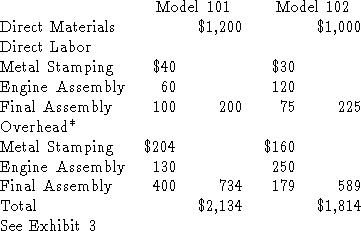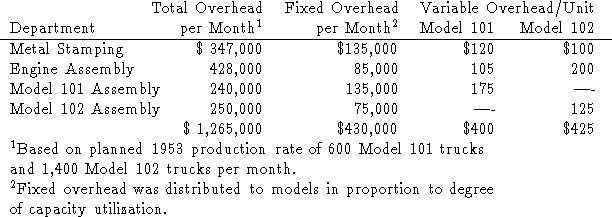
Table 2: Sheridan Production Data
The Sheridan Motor Company manufactured two specialized models of trucks in a single plant. Manufacturing operations were grouped into four departments: metal stamping, engine assembly, Model 101 assembly, and Model 102 assembly. Monthly production capacity was limited by the number of machine hours available in each department, as indicated in Table 2. The table also shows the amount of time each of the two models required for production in each department. The prices to dealers of the two models, f.o.b. the Sheridan plant, were $2,100 for the Model 101 and $2,000 For Model 102. Sheridan followed the price leadership of one of the larger manufacturers in the industry.

Table 2: Sheridan Production Data
As a result of a sellers market in 1953, Sheridan was able to sell as many trucks as it could produce. The production schedules it had followed during the first six months of the year resulted in a monthly output of 600 Model 101 trucks and 1,400 Model 102 trucks. At this level of production, both the Model- 102-assembly and the engine-assembly departments were operating at capacity, but the metal-stamping department was operating at only 64% of capacity and the Model-101-assembly department was at only 27%. Standard costs at this level of production are given in Table 3, and further details on overhead costs are in Table 4.
At a monthly planning session of the company's executives in July 1953, dissatisfaction was expressed with the company's profit performance as reported in the six-month income statement just prepared (see Exhibit 3). The sales manager pointed out that it was impossible to sell the Model 101 truck to yield a profit and suggested that it be dropped from the line in order to improve over-all profitability.
The controller objected to this suggestion. ``The real trouble, Dick, is that we are trying to absorb the entire fixed overhead of the Model 101 assembly department with only a small number of units production. Actually these units are making a contribution to overhead, even though it's not adequate to cover fixed costs, and we'd be worse off without them. In fact, it seems to me quite possible that we'd be better off increasing production of Model 101 trucks, cutting back if necessary on Model 102 production."
The production manager pointed out that there was another way in which output of Model 101 trucks could be stepped up, which would not require a cutback in Model 102 production. This would be through purchase of engines from an outside supplier, thus relieving the present capacity problem in the engine assembly department. If this course of action were followed, Sheridan would probably furnish the supplier with the necessary materials but would reimburse him for his labor and overhead.
At this point, the president entered the discussion. He asked the controller, the sales manager, and the production manager to get together to consider the two questions raised by their comments and to report their recommendations to him the next day. The two questions were: (1) Assuming no change in present capacity and demand, what would be the most profitable product mix? (2) What was the maximum labor and overhead charge Sheridan could afford to pay for engines if it purchased them from an outside supplier?
Question: What would be your reply to the questions raised by the president?

Table 3: Standard Costs of Two Truck Models

Table 4: Overhead Budget for 1953

Table 5: Income Statement for Six Months
Ending June 30, 1953
(thousands of dollars)